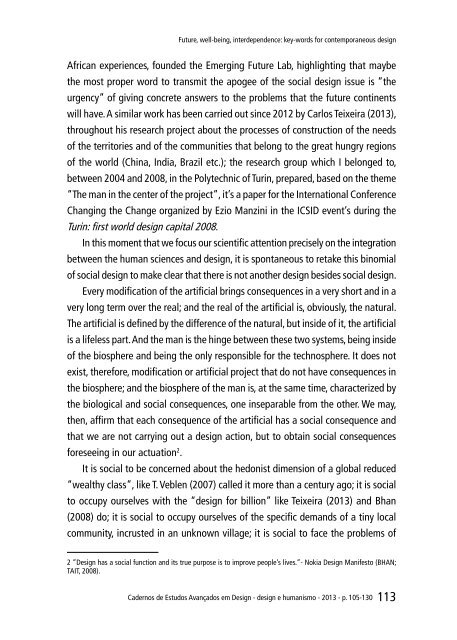o_19po8js951tvs1r0t1r8s4bb1vpla.pdf
You also want an ePaper? Increase the reach of your titles
YUMPU automatically turns print PDFs into web optimized ePapers that Google loves.
Future, well-being, interdependence: key-words for contemporaneous design<br />
African experiences, founded the Emerging Future Lab, highlighting that maybe<br />
the most proper word to transmit the apogee of the social design issue is “the<br />
urgency” of giving concrete answers to the problems that the future continents<br />
will have. A similar work has been carried out since 2012 by Carlos Teixeira (2013),<br />
throughout his research project about the processes of construction of the needs<br />
of the territories and of the communities that belong to the great hungry regions<br />
of the world (China, India, Brazil etc.); the research group which I belonged to,<br />
between 2004 and 2008, in the Polytechnic of Turin, prepared, based on the theme<br />
“The man in the center of the project”, it’s a paper for the International Conference<br />
Changing the Change organized by Ezio Manzini in the ICSID event’s during the<br />
Turin: first world design capital 2008.<br />
In this moment that we focus our scientific attention precisely on the integration<br />
between the human sciences and design, it is spontaneous to retake this binomial<br />
of social design to make clear that there is not another design besides social design.<br />
Every modification of the artificial brings consequences in a very short and in a<br />
very long term over the real; and the real of the artificial is, obviously, the natural.<br />
The artificial is defined by the difference of the natural, but inside of it, the artificial<br />
is a lifeless part. And the man is the hinge between these two systems, being inside<br />
of the biosphere and being the only responsible for the technosphere. It does not<br />
exist, therefore, modification or artificial project that do not have consequences in<br />
the biosphere; and the biosphere of the man is, at the same time, characterized by<br />
the biological and social consequences, one inseparable from the other. We may,<br />
then, affirm that each consequence of the artificial has a social consequence and<br />
that we are not carrying out a design action, but to obtain social consequences<br />
foreseeing in our actuation 2 .<br />
It is social to be concerned about the hedonist dimension of a global reduced<br />
“wealthy class”, like T. Veblen (2007) called it more than a century ago; it is social<br />
to occupy ourselves with the “design for billion” like Teixeira (2013) and Bhan<br />
(2008) do; it is social to occupy ourselves of the specific demands of a tiny local<br />
community, incrusted in an unknown village; it is social to face the problems of<br />
2 ”Design has a social function and its true purpose is to improve people’s lives.”- Nokia Design Manifesto (BHAN;<br />
TAIT, 2008).<br />
Cadernos de Estudos Avançados em Design - design e humanismo - 2013 - p. 105-130<br />
113



